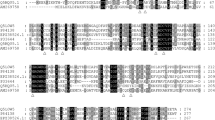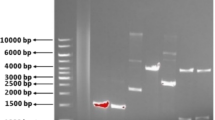Abstract
Laccases are widespread multi-copper oxidases and generally classified into three-domain laccases and two-domain laccases. In this study, a novel laccase PthLac from Parageobacillus thermoglucosidasius harbored only one domain of Cu-oxidase_4 and showed no sequence relatedness or structure similarity to three-domain and two-domain laccases. PthLac was heterologously expressed in Escherichia coli, purified, and characterized. The optimum temperature and pH of PthLac on guaiacol were at 60 ℃ and pH 6, respectively. The effects of various metal ions on PthLac were analyzed. All the tested metal ions did not suppress the activity of PthLac, except for 10 mM Cu2+, which increased the activity of PthLac to 316%, indicating that PthLac was activated by Cu2+. Meanwhile, PthLac kept 121% and 69% activity when incubated at concentrations of 2.5 and 3 M NaCl for 9 h, suggesting the long-term halotolerancy of this enzyme. In addition, PthLac showed resistance to the organic solvents and surfactants, and displayed dye decolorization capacity. This study enriched our knowledge about one-domain laccase and its potential industrial applications.





Similar content being viewed by others
Data Availability
All data generated or analyzed during this study are included in this published article and its supplementary information files.
References
Arregui, L., Ayala, M., Gomez-Gil, X., Gutierrez-Soto, G., Hernandez-Luna, C. E., de Los, H., Santos, M., Levin, L., Rojo-Dominguez, A., Romero-Martinez, D., Saparrat, M. C. N., Trujillo-Roldan, M. A., & Valdez-Cruz, N. A. (2019). Laccases: Structure, function, and potential application in water bioremediation. Microbial Cell Factories, 18(1), 200.
Janusz, G., Pawlik, A., Swiderska-Burek, U., Polak, J., Sulej, J., Jarosz-Wilkolazka, A., Paszczynski, A. (2020). Laccase properties, physiological functions, and evolution. International Journal of Molecular Science, 21(3).
Graff, M., Buchholz, P. C. F., Le Roes-Hill, M., & Pleiss, J. (2020). Multicopper oxidases: Modular structure, sequence space, and evolutionary relationships. Proteins, 88(10), 1329–1339.
Melo, E. P., Fernandes, A. T., Durao, P., & Martins, L. O. (2007). Insight into stability of CotA laccase from the spore coat of Bacillus subtilis. Biochemical Society Transactions, 35(Pt 6), 1579–1582.
Enguita, F. J., Martins, L. O., Henriques, A. O., & Carrondo, M. A. (2003). Crystal structure of a bacterial endospore coat component. A laccase with enhanced thermostability properties. Journal of Biological Chemistry, 278(21), 19416–25.
Skalova, T., Dohnalek, J., Ostergaard, L. H., Ostergaard, P. R., Kolenko, P., Duskova, J., Stepankova, A., & Hasek, J. (2009). The structure of the small laccase from Streptomyces coelicolor reveals a link between laccases and nitrite reductases. Journal of Molecular Biology, 385(4), 1165–1178.
Beloqui, A., Pita, M., Polaina, J., Martinez-Arias, A., Golyshina, O. V., Zumarraga, M., Yakimov, M. M., Garcia-Arellano, H., Alcalde, M., Fernandez, V. M., Elborough, K., Andreu, J. M., Ballesteros, A., Plou, F. J., Timmis, K. N., Ferrer, M., & Golyshin, P. N. (2006). Novel polyphenol oxidase mined from a metagenome expression library of bovine rumen: Biochemical properties, structural analysis, and phylogenetic relationships. Journal of Biological Chemistry, 281(32), 22933–22942.
Al-Kahem Al-Balawi, T. H., Wood, A. L., Solis, A., Cooper, T., & Barabote, R. D. (2017). Anoxybacillus sp. strain UARK-01, a new thermophilic soil bacterium with hyperthermostable alkaline laccase activity. Current Microbiology, 74(6), 762–771.
De Paula, N. M., da Silva, K., Brugnari, T., Haminiuk, C. W. I., & Maciel, G. M. (2022). Biotechnological potential of fungi from a mangrove ecosystem: Enzymes, salt tolerance and decolorization of a real textile effluent. Microbiological Research, 254, 126899.
Chandra, R., & Chowdhary, P. (2015). Properties of bacterial laccases and their application in bioremediation of industrial wastes. Environmental Science Processes & Impacts, 17(2), 326–342.
Mate, D. M., & Alcalde, M. (2017). Laccase: A multi-purpose biocatalyst at the forefront of biotechnology. Microbial Biotechnology, 10(6), 1457–1467.
Khatami, S. H., Vakili, O., Movahedpour, A., Ghesmati, Z., Ghasemi, H., & Taheri-Anganeh, M. (2022). Laccase: Various types and applications. Biotechnology and Applied Biochemistry, 69(6), 2658–2672.
Vieira, Y. A., Gurgel, D., Henriques, R. O., Machado, R. A. F., de Oliveira, D., Oechsler, B. F., & Furigo Junior, A. (2022). A perspective review on the application of polyacrylonitrile-based supports for laccase immobilization. Chemical Record, 22(2), e202100215.
Su, J., Fu, J., Wang, Q., Silva, C., & Cavaco-Paulo, A. (2018). Laccase: A green catalyst for the biosynthesis of poly-phenols. Critical Reviews in Biotechnology, 38(2), 294–307.
Fang, Z., Li, T., Wang, Q., Zhang, X., Peng, H., Fang, W., Hong, Y., Ge, H., & Xiao, Y. (2011). A bacterial laccase from marine microbial metagenome exhibiting chloride tolerance and dye decolorization ability. Applied Microbiology and Biotechnology, 89(4), 1103–1110.
Siroosi, M., Amoozegar, M. A., & Khajeh, K. (2016). Purification and characterization of an alkaline chloride-tolerant laccase from a halotolerant bacterium, Bacillus sp. strain WT. Journal of Molecular Catalysis B: Enzymatic, 134, 89–97.
Motamedi, E., Kavousi, K., Sadeghian Motahar, S. F., Reza Ghaffari, M., Sheykh Abdollahzadeh Mamaghani, A., Hosseini Salekdeh, G., & Ariaeenejad, S. (2021). Efficient removal of various textile dyes from wastewater by novel thermo-halotolerant laccase. Bioresource Technology, 337, 125468.
Zhou, J., Lian, J., & Rao, C. V. (2020). Metabolic engineering of Parageobacillus thermoglucosidasius for the efficient production of (2R, 3R)-butanediol. Applied Microbiology and Biotechnology, 104(10), 4303–4311.
Hussein, A. H., Lisowska, B. K., & Leak, D. J. (2015). The genus Geobacillus and their biotechnological potential. Advances in Applied Microbiology, 92, 1–48.
Aliyu, H., de Maayer, P., & Neumann, A. (2021). Not all that glitters is gold: The paradox of CO-dependent hydrogenogenesis in Parageobacillus thermoglucosidasius. Frontiers in Microbiology, 12, 784652.
Zhang, C., Wang, X., Zhang, W., Zhao, Y., & Lu, X. (2017). Expression and characterization of a glucose-tolerant beta-1,4-glucosidase with wide substrate specificity from Cytophaga hutchinsonii. Applied Microbiology and Biotechnology, 101(5), 1919–1926.
Wang, X., Zhao, D., Gao, L., Zhang, W., & Lu, X. (2020). Cage-like polyhedrons of DegQ from Cytophaga hutchinsonii show stable proteolytic activity and strong chaperone activity. Bio Eng J, 159, 107585.
Si, J., Ma, H., Cao, Y., Cui, B., & Dai, Y. (2021). Introducing a thermo-alkali-stable, metallic ion-tolerant laccase purified from white rot fungus Trametes hirsuta. Frontiers in Microbiology, 12, 670163.
Navas, L. E., Martinez, F. D., Taverna, M. E., Fetherolf, M. M., Eltis, L. D., Nicolau, V., Estenoz, D., Campos, E., Benintende, G. B., & Berretta, M. F. (2019). A thermostable laccase from Thermus sp. 2.9 and its potential for delignification of Eucalyptus biomass. AMB Express, 9(1), 24.
Othman, A. M., Elsayed, M. A., Elshafei, A. M., & Hassan, M. M. (2018). Purification and biochemical characterization of two isolated laccase isoforms from Agaricus bisporus CU13 and their potency in dye decolorization. International Journal of Biological Macromolecules, 113, 1142–1148.
Kumar, M., Mishra, A., Singh, S. S., Srivastava, S., & Thakur, I. S. (2018). Expression and characterization of novel laccase gene from Pandoraea sp. ISTKB and its application. International Journal of Biological Macromolecules, 115, 308–316.
Wang, X., Wang, Z., Bai, X., Zhao, Y., Zhang, W., & Lu, X. (2018). Deletion of a gene encoding a putative peptidoglycan-associated lipoprotein prevents degradation of the crystalline region of cellulose in Cytophaga hutchinsonii. Frontiers in Microbiology, 9, 632.
Mehandia, S., Sharma, S. C., & Arya, S. K. (2020). Isolation and characterization of an alkali and thermostable laccase from a novel Alcaligenes faecalis and its application in decolorization of synthetic dyes. Biotechnology Reports (Amsterdam, Netherlands), 25, e00413.
Mtibaa, R., de Eugenio, L., Ghariani, B., Louati, I., Belbahri, L., Nasri, M., & Mechichi, T. (2017). A halotolerant laccase from Chaetomium strain isolated from desert soil and its ability for dye decolourization. 3 Biotechnology, 7, 1–13.
Raseda, N., Hong, S., Kwon, O. Y., & Ryu, K. (2014). Kinetic evidence for the interactive inhibition of laccase from Trametes versicolor by pH and chloride. Journal of Microbiology and Biotechnology, 24(12), 1673–1678.
Damas, J. M., Baptista, A. M., & Soares, C. M. (2014). The pathway for O2 diffusion inside cota laccase and possible implications on the multicopper oxidases family. Journal of Chemical Theory and Computation, 10(8), 3525–3531.
Li, Z., Jiang, S., Xie, Y., Fang, Z., Xiao, Y., Fang, W., & Zhang, X. (2020). Mechanism of the salt activation of laccase Lac15. Biochemical and Biophysical Research Communications, 521(4), 997–1002.
Javadzadeh, S. G., & Asoodeh, A. (2020). A novel textile dye degrading extracellular laccase from symbiotic bacterium of Bacillus sp. CF96 isolated from gut termite (Anacanthotermes). International Journal of Biological Macromolecules, 145, 355–363.
Wang, S. N., Chen, Q. J., Zhu, M. J., Xue, F. Y., Li, W. C., Zhao, T. J., Li, G. D., & Zhang, G. Q. (2018). An extracellular yellow laccase from white rot fungus Trametes sp. F1635 and its mediator systems for dye decolorization. Biochimie, 148, 46–54.
Berini, F., Verce, M., Ausec, L., Rosini, E., Tonin, F., Pollegioni, L., & Mandic-Mulec, I. (2018). Isolation and characterization of a heterologously expressed bacterial laccase from the anaerobe Geobacter metallireducens. Applied Microbiology and Biotechnology, 102(5), 2425–2439.
Singh, G., & Arya, S. K. (2019). Utility of laccase in pulp and paper industry: A progressive step towards the green technology. International Journal of Biological Macromolecules, 134, 1070–1084.
Funding
This study was funded by the Key Scientific Projects for colleges of Henan Province (Grant number 21A180004), the Henan Provincial Science and Technology Research Project (Grant number 222102320250), and the Doctoral Scientific Research Start-up Foundation from Henan University of Technology (Grant number 2018BS080).
Author information
Authors and Affiliations
Contributions
XW, PC, HL, and JQ conceived and designed research. XW, PC, and ZL conducted experiments. XW analyzed data. XW and PC wrote the manuscript. All authors read and approved the manuscript.
Corresponding author
Ethics declarations
Ethics Approval and Consent to Participate
This study does not contain any studies with human participants or animals performed by any of the authors. Informed consent was obtained from all individual participants included in the study.
Consent for Publication
The participant has consented to the submission of the case report to the journal.
Competing Interests
The authors declare no competing interests.
Additional information
Publisher's Note
Springer Nature remains neutral with regard to jurisdictional claims in published maps and institutional affiliations.
Supplementary Information
Below is the link to the electronic supplementary material.
Rights and permissions
Springer Nature or its licensor (e.g. a society or other partner) holds exclusive rights to this article under a publishing agreement with the author(s) or other rightsholder(s); author self-archiving of the accepted manuscript version of this article is solely governed by the terms of such publishing agreement and applicable law.
About this article
Cite this article
Wang, X., Chen, P., Li, H. et al. Characterization of a Novel One-Domain Halotolerant Laccase from Parageobacillus thermoglucosidasius and Its Application in Dye Decolorization. Appl Biochem Biotechnol 195, 6465–6477 (2023). https://doi.org/10.1007/s12010-023-04389-x
Accepted:
Published:
Issue Date:
DOI: https://doi.org/10.1007/s12010-023-04389-x




